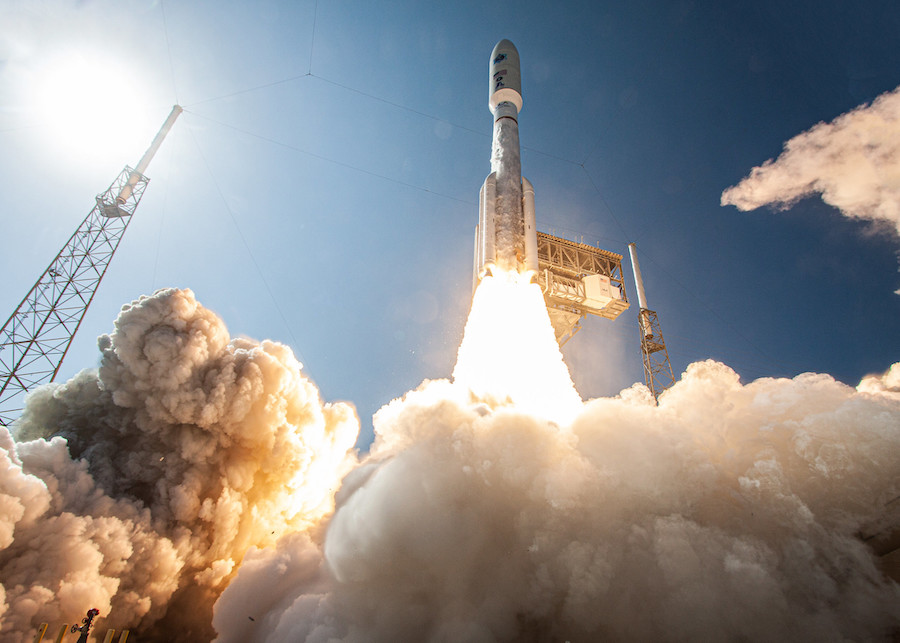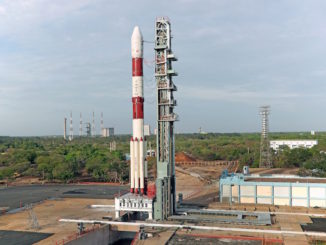
The sixth and final satellite in the U.S. military’s most secure satellite communications fleet lifted off from Cape Canaveral Thursday aboard a United Launch Alliance Atlas 5 rocket, extending the network’s expected lifetime beyond 2030.
The 197-foot-tall (60-meter) Atlas 5 rocket fired off pad 41 at Cape Canaveral Air Force Station at 4:18 p.m. EDT (2018 GMT) Thursday. The fiery start to the mission was delayed more than an hour for ULA teams to troubleshoot a problem with a ground hydraulics controller, which triggered a last-minute hold in the day’s first countdown.
The technical concern was cleared before the end of Thursday’s two-hour launch window, and the countdown resumed for another launch attempt. At T-minus 2.7 seconds, the rocket’s kerosene-fueled RD-180 engine flashed to life, followed seconds later by ignition of five strap-on solid rocket boosters.
The Atlas 5 climbed away from the launch pad with some 2.6 million pounds of thrust, turning east over the Atlantic Ocean with the U.S. military’s sixth Advanced Extremely High Frequency communications satellite.
The launcher’s boosters — made by Aerojet Rocketdyne — burned out and jettisoned less than two minutes after liftoff, followed by separation of the Atlas 5’s Swiss-made payload fairing. Four-and-a-half minutes into the mission, the Atlas 5’s first stage Russian-built main engine shut down, and stage separation occurred seconds later.
The Atlas 5’s Centaur upper stage ignited its RL10C-1 engine for the first of three burns to inject the AEHF 6 satellite into a unique, high-altitude transfer orbit on the way to a final operating post more than 22,000 miles (nearly 36,000 kilometers) over the equator.
Thursday’s mission marked the 500th production RL10 engine to be flown. RL10 engines, which burn liquid hydrogen and liquid oxygen propellants, have flown on Atlas, Saturn and Titan rockets, sending spacecraft toward every planet in the solar system.
After the Centaur’s second burn — around a half-hour after liftoff — the rocket released a small suitcase-sized CubeSat secondary payload named TDO 2.
Sponsored by the Air Force Research Laboratory and produced at the Georgia Institute of Technology, the TDO 2 spacecraft is based on a 12U CubeSat design. Its mission will support “space domain awareness” through optical calibration and satellite laser ranging, according to the U.S. Space Force’s Space and Missile Systems Center.
After deploying the TDO 2 payload, the Centaur coasted for five hours before reigniting the RL10 engine for a third time to reshape the rocket’s orbit. The final RL10 burn occurred at an altitude of around 22,000 miles (35,000 kilometers).
The planned 88-second burn raised the orbit’s perigee, or low point, and reduced its inclination. The maneuver placed the AEHF 6 spacecraft closer to its operating orbit, reducing the satellite’s expected fuel usage and extending its usable lifetime.
At 9:59 p.m. EDT (0159 GMT), the Centaur stage released the AEHF 6 spacecraft. Minutes later, satellite-builder Lockheed Martin confirmed ground teams were receiving signals from the new satellite.
“We are thrilled to accomplish this important milestone on the last AEHF satellite,” said Col. John Dukes, senior materiel leader for the geosynchronous orbit division of SMC’s production corps. “The combined integrated team worked diligently to ensure the success of this mission. The satellite is operating as expected and is ready to undergo orbit raising and on-orbit testing for the next several months after which it will provide mission critical capabilities to our warfighters.”

The successful launch Thursday marked the first deployment of a U.S. Space Force payload since the formal establishment of the new military service in December. The AEHF satellites were previously managed the Air Force, and the first five launched on Atlas 5 rockets from Cape Canaveral beginning in August 2010.
The Space Force remains part of the Air Force, but the new service took over units formerly under the authority of Air Force Space Command.
“Congratulations to the U.S. Space Force on liftoff of your first mission,” said Tory Bruno, ULA’s president and CEO, in a statement. “We are proud to be your partner for this historic mission and honored to have launched the entire Lockheed Martin produced AEHF constellation on Atlas 5 rockets. We understand the critical importance of delivering protected communications to strategic command and tactical warfighters operating on ground, sea and air.”
U.S. military satellite tracking data indicated the AEHF 6 spacecraft separated from the Centaur upper stage in an elliptical transfer orbit ranging between 6,767 miles (10,891 kilometers) and 21,492 miles (35,313 kilometers), with an inclination of 13.7 degrees to the equator.
Those orbit figures were very close to pre-launch predictions. The RL10’s final burn before deploying the AEHF 6 satellite was programmed to continue until sensors detected a low propellant level on the Centaur stage, ensuring the payload reached the best orbit possible.
The AEHF 6 satellite will use its own engine and plasma thrusters to maneuver into a circular geostationary orbit more than 22,000 miles over the equator, where the craft’s speed will match the rate of Earth’s rotation. That will allow AEHF 6 to remain over the same part of the world 24 hours per day.
Military officials have not disclosed the geographic coverage area for AEHF 6.
Designed to operate at least 14 years, the AEHF satellites are follow-ons to the Air Force’s Milstar satellite network.
Each of the AEHF satellites, which are spread around the world to enable global coverage, provides more capacity than the entire five-satellite Milstar constellation, which launched in the 1990s and 2000s. The AEHF satellites are cross-linked with one another, allowing the network to beam signals around the world without going through a ground station.
AEHF 6 will go straight into operations once it passes post-launch tests, Space Force officials said.
The AEHF satellites provide connectivity at different specified data rates between 75 bits per second to 8 megabits per second. Those data rates are slow by modern standards, but what distinguishes the AEHF satellites is their ability to resist jamming and continue operating, even in the event of nuclear war.
Each satellite also carries gimbaled dish antennas to reach users on-the-move, phased array antennas with beams can be steered electronically rather than mechanically, and nulling antennas to provide “extremely high anti-jam capability to in-theater users,” according to Northrop Grumman, supplier of the AEHF communications payload.
“AEHF, if we were to have to operate in (the highest bandwidth) mode, will enable the President of the United States, national leaders and four international allies to be able to communicate in voice-recognizable communication, even through any event,” Dukes said.
The governments of Australia, Canada, the Netherlands and the United Kingdom have joined the AEHF program.
“Across the globe, we have numerous Army, Navy, Air Force, and joint international partner terminals with the AEHF constellation online,” Dukes said. “We have enough bandwidth to service all the terminals in our concept of operations. So by upgrading from the Milstar to the AEHF constellation, we’re able to provide that capability from now to beyond 2030.”
Thursday’s launch went ahead amid the coronavirus pandemic, which has forced delays in many upcoming launches.
But the launch of the AEHF 6 satellite was deemed critical by military leaders.
“There are critical things or mission-essential things that the U.S. Department of Defense does every day, regardless of what the current global situation is,” said Lt. Gen. John “JT” Thompson, commander of the Space and Missile Systems Center at Los Angeles Air Force Base. “So even in the face of a global pandemic like the COVID-19 crisis, we must continue to perform mission-essential tasks.
“One of those mission-essential tasks, one of those things that we have to do for the warfighter and for the United States of America is launch AEHF 6,” Thompson said. “It is designated mission-essential, and it’s because the AEHF constellation supports the President of the United States, other national leaders and the joint forces with critical strategic communications around the planet.
“This particular launch extends that capability out into the timeframe beyond 2030,” Thompson said.
ULA says its next Atlas 5 launch is scheduled for May, when the next flight of the military’s X-37B spaceplane is scheduled for takeoff from Cape Canaveral.
Email the author.
Follow Stephen Clark on Twitter: @StephenClark1.



